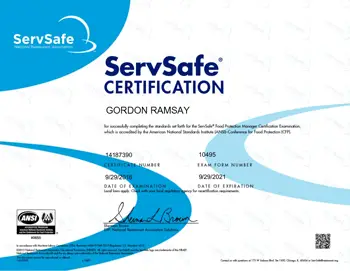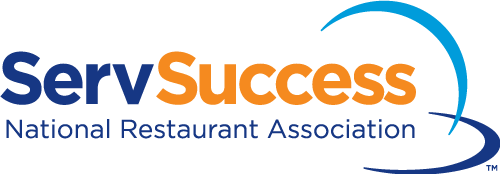Secret Duties and Training for Aiming ServSafe Managers in the Food Sector
Secret Duties and Training for Aiming ServSafe Managers in the Food Sector
Blog Article
Fast and Reliable Food Handlers Training for Certification
In the food solution industry, the importance of efficient and fast food trainers educating for certification can not be overemphasized. Adequate training makes certain that employees are knowledgeable concerning critical food safety and security techniques, ultimately safeguarding public health and enhancing functional performance. This conversation will explore crucial components of successful training programs, the benefits of rapid accreditation, and practical ideas for application. The genuine concern continues to be: how can services properly evaluate the effect of their training efforts on lasting food safety and security compliance?
Relevance of Food Safety Training
Although food safety training might seem like a basic demand for food handlers, its significance can not be overemphasized. The food market is naturally vulnerable to a variety of health dangers, including foodborne ailments that can emerge from inappropriate handling, storage space, and preparation methods. Reliable training equips food trainers with the expertise needed to reduce these risks, therefore making sure the safety and security and quality of the food being served.
Furthermore, food safety and security training promotes a society of responsibility and diligence among staff. They are a lot more most likely to adhere to protocols and report prospective hazards when employees recognize the crucial role they play in preserving health standards. This proactive technique not only shields customers however likewise improves the reputation of the establishment.
Therefore, investing in comprehensive food security training is not simply a legal procedure but a strategic choice that safeguards public health and wellness and maintains organization stability. Eventually, the relevance of food safety training extends past private responsibility; it is a foundational component that supports the integrity of the whole food supply chain.
Key Elements of Training Programs

Firstly, the training material should cover critical topics such as cross-contamination, correct food storage space, temperature control, and individual hygiene techniques (servsafe food handler). This ensures that food trainers are well-versed in the vital principles of food safety
Second of all, the educational methods used in training programs play a vital function in improving understanding and retention. Making use of a mix of interactive techniques, such as hands-on demos, seminar, and multimedia discussions, can deal with diverse discovering designs and improve interaction.
Last but not least, durable assessment strategies are essential for examining the effectiveness of the training program. Implementing tests, sensible assessments, and real-world circumstances not only helps in strengthening understanding yet additionally ensures that food handlers can apply what they have actually discovered in their day-to-day tasks.
Advantages of Quick Accreditation
Fast qualification in food handling supplies various advantages, especially in today's fast-paced food industry. One of one of the most significant benefits is the ability to quickly outfit employees with necessary understanding and skills, ensuring compliance with health policies. This accelerates the onboarding procedure, enabling restaurants and food solution facilities to preserve procedures without lengthy delays.
Additionally, fast accreditation programs are often extra easily accessible, accommodating a diverse range of discovering routines and styles. These programs generally utilize engaging methods such as interactive workshops or on-line modules, which can boost retention of essential information.

Furthermore, quick qualification can minimize the risk of foodborne illnesses, which can dramatically impact an organization's online reputation and profits. By making sure that all workers are promptly educated and accredited, establishments can foster a society of food security, inevitably check my source profiting both business and its consumers. In general, fast certification represents a calculated advantage in a competitive sector.
Tips for Effective Execution

Efficient application of food handler training programs is vital for maximizing the benefits of rapid certification. To attain this, organizations ought to begin by clearly defining their training purposes and aligning them with regulative needs. This makes sure that all required topics are covered why not look here adequately.
Making use of technology can streamline the training process. Online modules enable adaptable organizing, enabling workers to finish training at their comfort while lowering downtime. Including interactive aspects, such as quizzes and scenario-based understanding, can boost involvement and retention of information.
It is also vital to develop an organized timeline for training sessions, allowing adequate time for both instruction and useful application - servsafe manager. This may include hands-on presentations of correct food managing methods, which are critical for strengthening understanding
Regular communication with staff about training assumptions and results fosters a society of liability and urges participation. Lastly, supplying access to additional resources and support products can improve understanding and address any type of lingering inquiries.
Examining Training Performance
Evaluating the performance of food trainer training programs is important for guaranteeing that employees not just acquire the needed expertise but additionally apply it in their everyday jobs. A detailed assessment procedure can include numerous approaches, including pre- and post-training assessments, direct monitorings of food dealing with methods, and employee feedback studies.
Pre- and post-training evaluations help to determine the understanding acquired by workers, supplying quantitative information that can indicate the effectiveness of the training material. servsafe certifications. These assessments must cover crucial topics such as food security guidelines, personal health criteria, and cross-contamination prevention
Straight observations of employees in their workplace are crucial for evaluating the functional application of discovered abilities. Observations allow trainers and administration to determine locations where employees may have a hard time and call for additional support or re-training.
Furthermore, collecting comments via surveys from participants can offer understandings right into the training's relevance, pacing, and total effectiveness. Involving workers in this comments procedure can cultivate a culture of constant improvement.
Verdict
Finally, quickly and efficient food handlers educating for qualification is essential for preserving high food security requirements. Comprehensive training programs that encompass essential topics, together with quick qualification processes, improve employee readiness and confidence. The implementation of reliable training techniques not only mitigates the threat of foodborne ailments however additionally boosts the track record and monetary security of services. Continuous examination of training efficiency further ensures that food security practices remain present and effective in a vibrant market environment.
In the food service industry, the value of fast and efficient food handlers educating for qualification can not be overstated.Although food safety and security training might appear like a basic need for food handlers, its value can not be overstated. Reliable training outfits food handlers with the knowledge required to alleviate these threats, thereby guaranteeing the safety and security and quality of the food being offered.
Inevitably, the importance of food safety training extends past specific obligation; it is a foundational aspect that sustains the honesty of the entire food supply chain.
In verdict, quickly servsafe certifications and reliable food trainers training for certification is essential for maintaining high food safety and security criteria.
Report this page